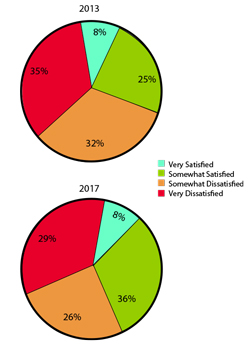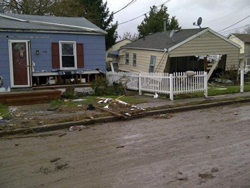According to a poll by the Monmouth University Polling Institute, a majority of New Jersey residents who were ‘hard hit’ victims of Superstorm Sandy are dissatisfied with the government aid they received.
The poll also showed that some victims are still suffering, even five years after the storm made landfall on Oct. 29, 2012.
“Monmouth has been tracking some of New Jersey’s hardest-hit Sandy victims for nearly five years, and it is clear that the slow rate of recovery is something many will never be able to get over,” said Patrick Murray, Director of the Monmouth University Polling Institute, in the polls results report. “We have certainly seen some improvement in these residents’ attitudes. But with nearly 1-in-10 of those surveyed still waiting to return home, it is unlikely that a majority of Sandy victims will ever be satisfied with how New Jersey has handled the recovery.”
This year’s poll addressed 432 families who were classified as suffering the greatest after-effects of the storm in 2013. The families had either been displaced from their homes or obtained damages that cost more than $8,000.
The poll found that 55 percent of those surveyed felt dissatisfied, compared to 67 percent in 2013. Of that number, 29 percent felt “very dissatisfied,” while 26 percent are “somewhat dissatisfied,” according to the polling institute’s website. Only 9 percent are “very satisfied” with the recovery effort, and another 35 percent are “somewhat satisfied.”
The report found that among people who have been able to move back into properties that were damaged by Sandy, the satisfaction rate was 50 percent. Only 29 percent of those who have permanently relocated, or are waiting to move back, are satisfied with the state.
 “A surprising number of people are still out of their homes,” said Carolyn Lau, a research assistant at the Polling Institute. “They are still caught up in the Rehabilitation, Reconstruction, Elevation, and Migration (RREM) process, the government program for rebuilding assistance. It definitely hasn’t been resolved for everyone.”
“A surprising number of people are still out of their homes,” said Carolyn Lau, a research assistant at the Polling Institute. “They are still caught up in the Rehabilitation, Reconstruction, Elevation, and Migration (RREM) process, the government program for rebuilding assistance. It definitely hasn’t been resolved for everyone.”
Lau said that the institute hopes that by continuing to keep the results of the polls in the news, policymakers will be aware of the troubles that the people who were hurt by Sandy still face.
“We’re hoping that New Jersey lawmakers take note to address the issues that people are still facing,” Lau said. “We don’t know if they will or not, but that’s the idea.”
According to RREM’s website, the program stopped accepting applications in August 2013, less than a year after Sandy.
56 percent of those surveyed said that they believe “people like them have been forgotten in the recovery effort.” Only 44 percent believe that the efforts are focused on helping them, an increase from 24 percent in 2013.
“My dad’s friend lived on the water in my town, and she got so much water in her house that there was too much damage to save it,” said Ally Rao, a senior English student who lives in Little Egg Harbor. “She needed to rebuild her house and lift it, and the construction company started work, got paid, and then just didn’t finish the job.”
“Her house has been half-fixed for years now, and she doesn’t have the money to fix it, so she’s been fighting this for years, in order to either get the job done, or get her money back,” added Rao.
According to The Atlantic, state officials had estimated that Sandy recovery efforts would take about two years. However, according to statistics taken by the Internal Displacement Monitoring Center (IDMC), 39,000 people in affected areas were still in need of “permanent housing or assistance with housing.”
“There was never any clarity for these homeowners from day one,” said Sue Marticek, the executive director of the Ocean County Long Term Recovery Group (OCLTRG) in a 2016 interview with 92.7 WOBM. “You have one government agency telling you to do one thing, you have another government agency telling you to do another. The lack of clarity for these homeowners, from the start, has really cost them a lot.”
Marticek claimed that there were three major obstacles facing Sandy survivors. Firstly, there are difficulties with the National Flood Insurance Program (NFIP) process and claims – some homeowners, in 2015, are being asked to go back and show evidence as to why they need funding.
She also believed that survivors were having difficulties navigating the RREM program, or being finished with it. According to the Asbury Park Press, 8,642 homeowners in New Jersey were approved for RREM grants. However, as of July 2015, only 1,349 homes had been rebuilt through the program – barely over 16 percent. The homes rebuilt were not necessarily elevated, either, which is considered a step of the program.
Erica Deweever, a senior business marketing and decision sciences student, said “When I heard that people were dissatisfied with the help they received, my immediate reaction was that they did not put forth enough effort to receive aid. There are so many grants and rebuilding funds available to victims, you just need to go out and get it. I feel like people want a check to arrive at their door. Like all other government supplied financial aid, you have to put work in to receive it.”
Marticek also said that the process was made more complicated due to claims of contractor fraud and disputes. One such dispute took place within the RREM program, as homes were transferred to a different builder, delaying recovery.
Carly Miller, a senior homeland security student, believes that efforts from the Federal Emergency Management Agency (FEMA) and the NJ government, ‘though they did not save houses, did save lives.’ Miller maintains the perspective that preparation and rebuilding efforts done from the government and community were united and successful at rebuilding those affected.
Miller said, “Agencies such as FEMA and other first responders were prepared ahead of time for damage that was to come. Due to the immense preparedness for this threat, Superstorm Sandy caused colossal damage to infrastructure, but less damage to human life. The main reasons that this storm was a Department of Homeland Security (DHS) success for the most part was due to extreme preparedness, communication, and trust with outside sources such as scientists and weathermen.
According to the Asbury Park Press, New Jersey paid out about 5.4 million dollars to homeowners whose grant money was taken by contractors who failed to complete repair or elevation projects. The state’s Division of Consumer Affairs has also filed civil actions against eight home improvement contractors, claiming that they defrauded victims of more than five million dollars in federal rebuilding aid.
In addition to difficulties in getting aid and having the work completed, FEMA requested that two percent of the people given aid (about 3,600 people) repay at least part of the money they were given, according to NPR.
According to FEMA, they had “overpaid their storm recovery funds,” and were hoping to recoup at least $24 million. Each family on average will have to pay back more than $6,000, and more than half of the families being asked to return aid money makes less than $50,000 a year.
According to the polling institute, 54 percent of respondents said that their family’s financial situation is currently worse than it was before the storm, while about 36 percent say that their situation is about the same.
PHOTO COURTESY of Denise O’Kenney
IMAGE COMPILED by Courtney Buell




